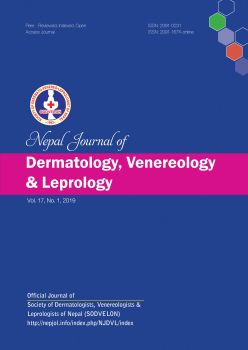Profile of Clients of HIV Testing and Counseling in a Tertiary Care Center and Need of Testing in Tuberculosis
DOI:
https://doi.org/10.3126/njdvl.v17i1.23251Keywords:
Acquired Immunodeficiency Syndrome, HIV infections, Sexually Transmitted Diseases, TuberculosisAbstract
Introduction: Sexually transmitted infection is public health issue that amplifies HIV burden globally. At National Center of AIDS and STD Control, annual reported STI are rising steeply recently. Incidence of HIV is 0.03% while prevalence in adult population is less than 1%. National HIV testing guidelines 2017 recommends HIV tests should be performed in tuberculosis and medical conditions. However, it is not routinely done in Nepal.
Objective: To assess profile of STI and HIV among patients attending HIV testing and counseling center of tertiary hospital, and to assess fraction of tuberculosis patients undergoing HIV testing.
Materials and Methods: All patients attending HIV testing and counseling center were tested for HIV. Tests for STI were done based on patient symptoms. Data collected were analyzed with SPSS.
Results: Suspected STI (41.1%) was commonest cause of HIV testing. Among STI, gram positive diplococcic were noted in 11.5% and 3.4% had PCR positive Chlamydia. Only 19.4% (7 out of 36) of total tuberculosis patients in hospital were screened for HIV, among which, 57.14% (4 out of 7) were seropositive for HIV, which is noteworthy.
Conclusion: Our study shows patterns of STI, and that gonorrhea and chlamydia could be underdiagnosed in Nepal. Every patient with tuberculosis should routinely be screened for HIV. But only small fraction of tuberculosis patients underwent HIV screening, out of which HIV positivity was high, reflecting the gap and need for routine HIV screening in TB patients.
Downloads
Downloads
Published
How to Cite
Issue
Section
License
Copyright on any research article is transferred in full to Nepal Journal of Dermatology, Venereology & Leprology upon publication. The copyright transfer includes the right to reproduce and distribute the article in any form of reproduction (printing, electronic media or any other form).




